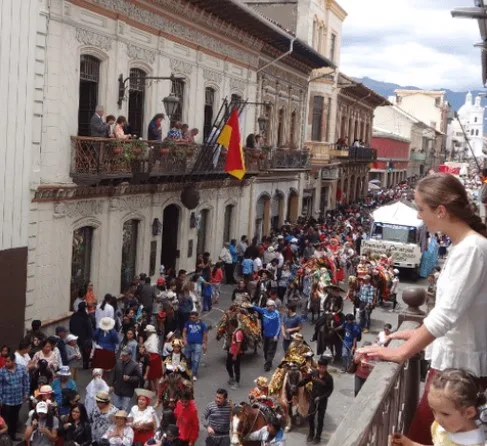An estimated 150,000 watched or participated in Sunday’s Pase del Niño Christmas Eve parade

In a ceremony before the Pase del Niño parade begins, the sacred statue is handed off at the cathedral to a family or organization that will be responsible for its safe keeping during the day’s events. (El Mercurio)
By Sylvan Hardy
A crowd estimated at 100,000 lined the streets and balconies of Calle Simon Bolivar Sunday to watch Cuenca’s Christmas Eve parade, the Pase del Niño, or the Passing of the Child. In addition to onlookers, the event featured about 50,000 participants, mostly children, who walked and rolled from San Sebastian Plaza to Parque San Blas.

As the parade name implies, Pase del Niño is mostly about the kids. (El Mercurio)
The biggest public event of the year in Cuenca, the parade is a colorful mixture of the sacred and sometimes the profane. To locals, it is a time-honored Christian festival of homage to the Christ child that combines Catholic and indigenous traditions.
The seven-hour-plus procession stepped off about 10 from the staging area just west of San Sebastián Plaza and featured floats and decorated cars and trucks, many festooned with flowers, fruits, candy, vegetables, beer cans and liquor bottles. Hood ornaments included roasted pigs, chickens and guinea pigs. There were bands, dancers, a variety of street performers, children on horses and donkeys, and various Biblical characters.

Pase del Niño organizers estimated that 150,000 participated in the parade or watched along the Calle Simon Bolivar route.
Introduced to Latin America by the Spanish almost 500 years ago, the Pase del Niño is a Christmas celebration in which likenesses of the infant Jesus are carried through towns and villages. In Ecuador, the tradition remains strongest in the Andean region. Organizers of the Cuenca parade claim it is the largest Pase del Niño in the region.
The parade is actually a collection of dozens of smaller parades, according to José Washington Noroña, one of the event’s organizers. “Every neighborhood and nearby town will have its own parade with its own entries. Each will carry its own statue of the Christ child. This is something that communities plan for the entire year.
Although most entries are from Cuenca and the surrounding area, some come from as far away as Loja in the south and Otavalo in the north,” says Noroña.

After the parade is over, it’s time for a rest.
Although the Christmas Eve parade may be the main event, the Pase del Niño celebration is a three-month-long activity, beginning the first Sunday after Advent and continuing until Carnival in February. The tradition also includes Novenas, nine consecutive nights of song, food and prayer, celebrated in homes and churches. On Christmas Eve, the Misa del Gallo, or Rooster Mass, was celebrated in the Cathedral and local churches.
Organizers say that the parade has a strong connection to the United States. Ecuadorians who live in the U.S. are major contributors, says Noroña. “Those who have done well there send money as thanks for their safe passage and future success.”
The centerpiece of Cuenca’s parade, El Niño, is an 1823 sculpture of the infant Jesus that was commissioned by Cuencano Josefa Heredia from an unknown local artist. When the sculpture came into the possession of Cuenca Monsignor Miguel Cordero Crespo more than a century later, he took it to the Holy Land and Rome in 1961, where it was blessed by Pope John XXIII. After the journey and the anointment, the statute became known as Niño Viajero, or Traveling Child, and has been the parade´s main attraction ever since.





















